#masonry company chicago
Explore tagged Tumblr posts
Text
The Ultimate Guide to Choosing a Masonry Restoration Company
In the bustling metropolis of Chicago, maintaining the timeless beauty of historic buildings is a top priority. As the years pass, the elegant facades of these structures can start to show signs of wear and tear, requiring the expertise of a masonry restoration company to preserve their grandeur. Whether you're a property owner, manager, or developer, selecting the right masonry repair company is crucial to safeguarding your investment and maintaining the structural integrity of your building.
Why Masonry Restoration Matters
Masonry, with its enduring appeal and durability, is a hallmark of architectural excellence. However, exposure to harsh weather conditions, pollution, and the passage of time can take a toll on even the sturdiest of structures. This is where masonry cleaning company comes in. With their specialized knowledge and advanced techniques, they can breathe new life into weathered facades, ensuring that the beauty of your building stands the test of time.
Key Considerations When Choosing a Masonry Restoration Company
Expertise and Experience
When entrusting your building's restoration to a masonry company Chicago, you want assurance that you're dealing with seasoned professionals. Look for a company with a proven track record of success and extensive experience in handling projects similar to yours. Expertise in a wide range of restoration techniques, from tuckpointing to stone replacement, is essential to addressing the unique needs of your building.
Quality of Workmanship
Superior craftsmanship is non-negotiable when it comes to masonry restoration. Insist on viewing past projects and client testimonials to gauge the quality of the company's work. Attention to detail, precision in execution, and adherence to industry standards are hallmarks of a reputable masonry repair company.
Range of Services
A comprehensive suite of services is indicative of a masonry cleaning company's capability to address diverse restoration needs. From routine maintenance to intricate repairs, choose a company that offers a wide range of services tailored to your building's requirements. Whether it's brick cleaning, mortar repointing, or facade preservation, versatility is key.
Use of Quality Materials
The longevity of masonry restoration depends heavily on the quality of materials used. Ensure that the masonry company Chicago sources materials from trusted suppliers known for their durability and authenticity. Whether it's reclaimed bricks, natural stone, or eco-friendly cleaning agents, prioritize companies that prioritize quality in every aspect of their work.
Commitment to Preservation
Preserving the architectural heritage of Chicago's iconic buildings requires a deep commitment to conservation principles. Seek out masonry restoration companies that prioritize preservation over quick fixes, employing techniques that respect the integrity of historic structures while enhancing their longevity. A company that understands the importance of heritage preservation is a valuable partner in safeguarding Chicago's architectural legacy.
#masonry restoration company#masonry repair company#masonry company chicago#masonry cleaning company
0 notes
Text
New Frontier Construction Exterior Specialists, Roofing and Masonry Restorations | Construction Company | Masonry Contractor in Chicago IL
Ours is the most reputable Construction Company in Chicago IL, where we are committed to delivering high-quality construction services. Our experienced team of professionals is dedicated to turning your vision into reality, utilizing the latest techniques and materials. We handle every aspect of the project with meticulous attention to detail. Moreover, we also have a well-earned reputation as the most notable Masonry Contractor in Chicago IL. Whether you want to construct a block wall or need to repair damaged mortar in brickwork, we do it all with precision. From us, you can always expect quality work and superior craftsmanship. So, if you need our expert assistance, call us today.

#Construction Company in Chicago IL#Masonry Contractor in Chicago IL#Professional Painters near me#Roofing Companies near me#Brick Works near me
1 note
·
View note
Text
Did you know that the Catalan vault can be found in many buildings of the United States of America?
Here's some examples:

Grand Central Terminal, New York City. Photo from Getty.

Boston Public Library. Photo by Michael Freeman/Boston Public Library.

Ellis Island Registry Room, New York. Photo by Mike Ward on Flickr.

City Hall station of the New York subway. Photo by Michael Freeman.
The Catalan vault is a brick arch that is widely used in traditional Catalan architecture. It's also present in other parts of the Mediterranean, but not as common. Its main characteristic is that it's built with the longest side of the brick facing down (usually, ceilings are made with the shortest side facing down) and with a very gentle curve, resulting in a strong self-supporting vault that allows covering a whole room without needing columns or pillars in a way that would be impossible with other kinds of masonry, and also makes it possible to build it quickly and without needing centering (the wooden structure used to support the vault or arch while it's being built, and which is removed once it's made).
So how did it make its way to the USA?
It was brought by the Valencian architect Rafael Guastavino i Moreno (1842-1908). He had already designed important industrial buildings in Catalonia, including the factory that later became the Industrial School in Barcelona and La Massa theatre in Vilassar de Dalt, among others. At the time, in Catalonia, the Catalan vault was being widely used to cover ceilings in factories.
In 1881, Guastavino moved to New York City (USA), where he used the Catalan vault to cover big ceilings, which made him gain some fame for it. He patented the vault in the USA with the name "Guastavino system".
At the time, Americans were very worried about buildings catching fire, because it often happened and had caused a huge destruction in the Chicago 1871 fire. As a response, in 1883 Guastavino bought a patch of land in Connecticut, built two houses in it using the Catalan vault, and set them on fire. He took photos of the whole process to document it and prove how this architecture style is efficient in the case of fire. He wrote about it in the magazine Decorator and Furnisher and soon won the contest to design the Progress Club's building in New York City, which made him famous among architects in the area.
He created his own company (Guastavino Fireproof Construction Company) which was focused on building the Catalan vault. He was hired for many buildings and this architectural element spread. Most churches with stone vaults built between 1890 and 1940 in the USA were designed by Guastavino's firm, as well as many other buildings across the country, particularly New York and Massachusetts.
He's buried in the St. Lawrence Basilica in Asheville (North Carolina, USA), a building he designed.
#arquitectura#arts#història#architecture#new york#new york city#usa#architecture history#art history#guastavino#guastavino tiles#vault#beaux arts#modern architecture#north carolina#other countries#valència#país valencià#diaspora
63 notes
·
View notes
Text
Fisher Building, Chicago
343 South Dearborn Street
Completed 1896; addition 1907
Charles Atwood, D.H. Burnham & Co. architects
1907 addition, Peter J. Weber, architect
2001 restoration and adaptive reuse, Pappageorge Haymes, supervising architects
by Roger Jones, August 2023
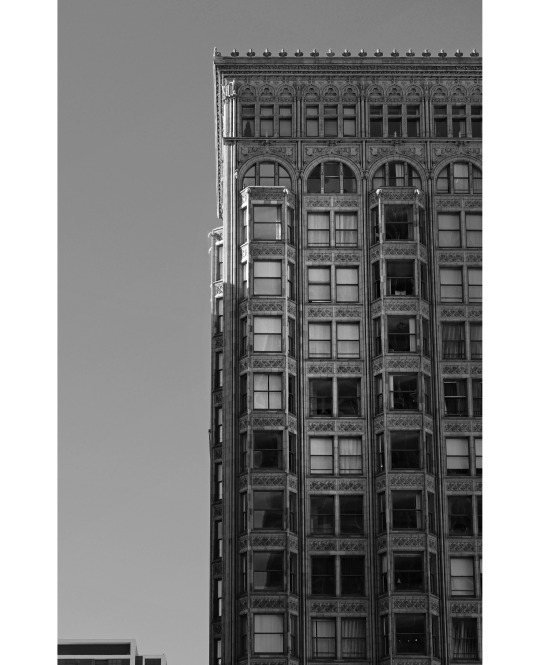
Fisher Building, photo by Roger Jones
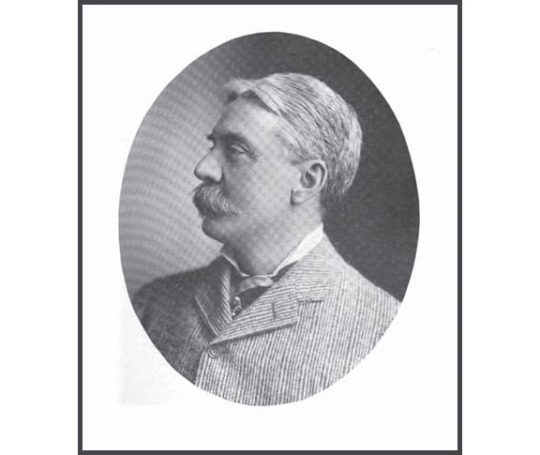
Lucius Fisher (1843-1916). He was a Chicago, Illinois paper company magnate and architect. In 1895, he commissioned Daniel Burnham and Company to build the 20 story, 275 foot tall Fisher Building in the Chicago Loop.
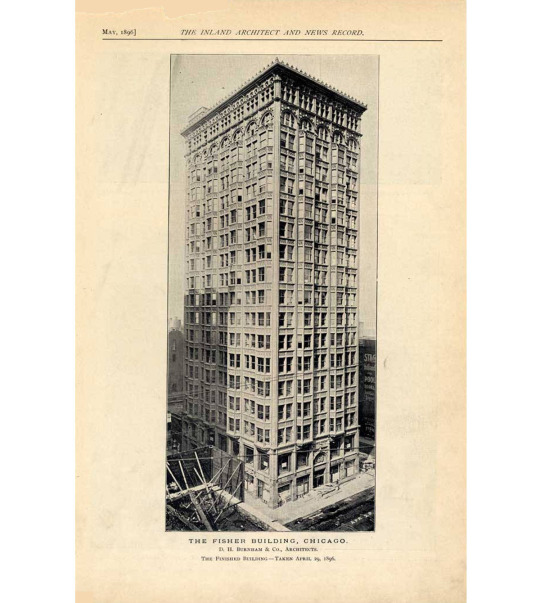
Fisher Building, Chicago, taken April 29, 1896. From The Inland Architect and News Record, May 1896. [Link to full article PDF here]
The writer of the 1896 article described the building thus:
But here, for what we believe to be the first time in human experience, one of the highest commercial buildings in the world has been erected almost without any bricks. It fronts on three streets, and on the remaining side adjoins other property. The fronts are covered with cellular terra cotta on the outside, not in imitation of a wall, but following upward the steel supporting members, and closing in the transoms between the windows, leaving two-thirds of the exterior to be enclosed by glass… Only two bricklayers were employed at any time in this part of the work.
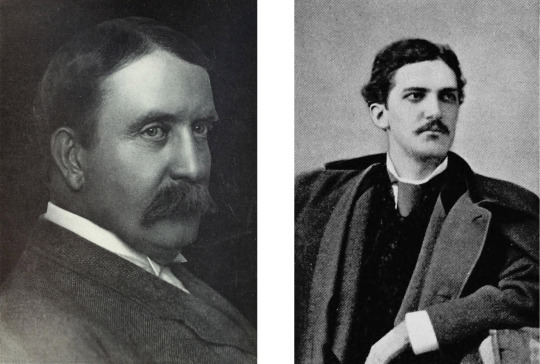
(Left) Daniel H. Burnham (1846-1912)
(Right) Charles B. Atwood (1849-1895)
The Fisher Building, 343 South Dearborn Street in the Chicago Loop, was commissioned by paper magnate Lucius Fisher. The original 18-story building was completed in 1896 by D.H. Burnham & Company; the architect was Charles B. Atwood, who died before the building's completion. An addition was later added in 1907.
Some facts about the building, from the Emporis site:
The original wing was only the second building in Chicago to reach 18 stories (after the Masonic Temple), and is the oldest still standing at that height.
Because of the building's great height for its time, the usual spread foundations were supplemented with piles underneath them to support the added weight.
The second floor was originally a banking room, and has especially large windows compared to the floors above it.
To enhance the facade's vertical emphasis, most of the ornamentation is placed on its horizontal members, reducing the banding effect that would occur if they were blank.
The Gothic ornament is in the 15th century style of Bruges and Rouen.
Declaring the structure a Chicago Landmark in 1978, the Landmarks Division noted:
Cladding this early skyscraper with Gothic-inspired, terra-cotta tracery was not a casual stylistic choice. Its designers looked for inspiration to the early Gothic cathedrals of Europe, which shared common characteristics of tallness and often having more glass than masonry. Cut glass door panel Eagles and mythical beasts decorate the upper stories, and aquatic creatures and seashells--a visual pun on the name of the building's original owner, Lucius G. Fisher--are found at the base. A later addition to the north is largely a repetition of the original design, except for the absence of bay windows.
Early postcard views of the building
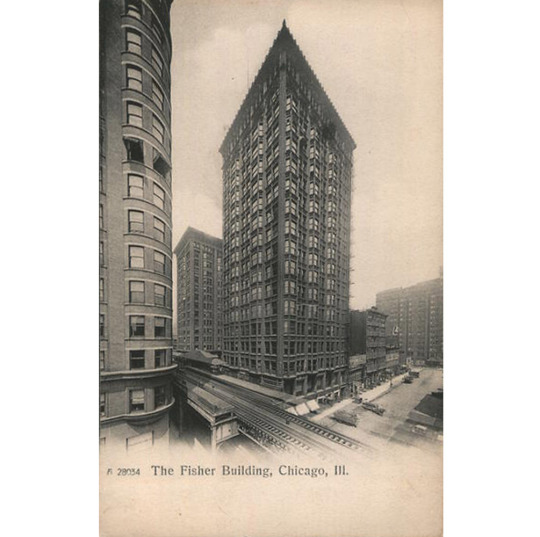
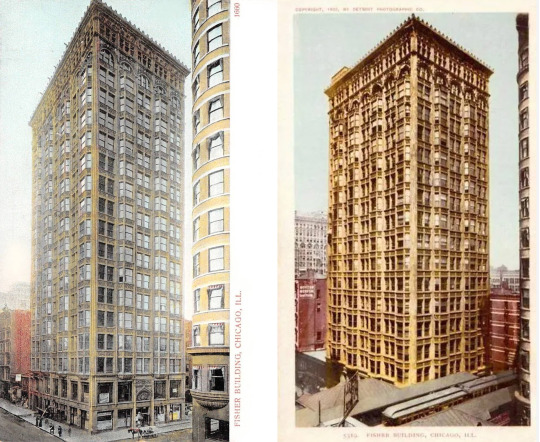
Archival photos
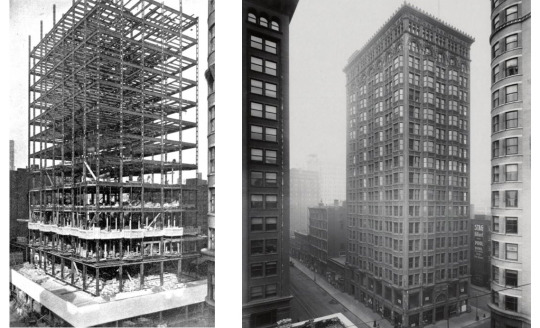
Fisher Building under construction (left) and on completion (right)
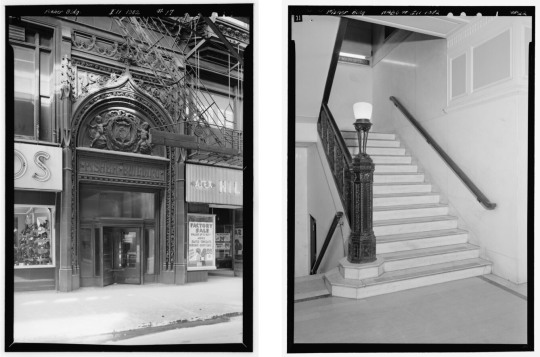
Van Buren (main) entrance; Lobby stairs
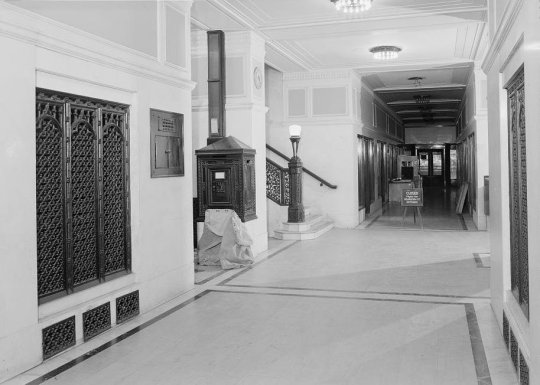
Entrance hall

First story entrance corridor in 1896

Original elevator cage
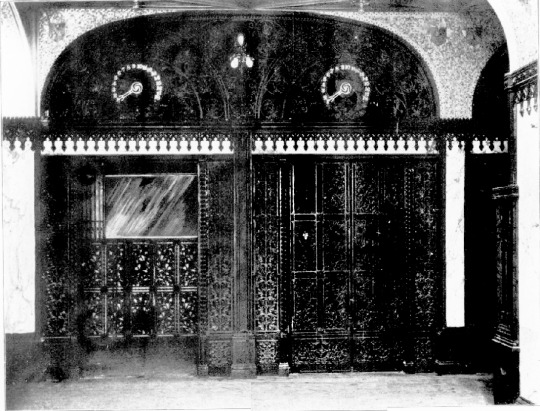
Original elevators
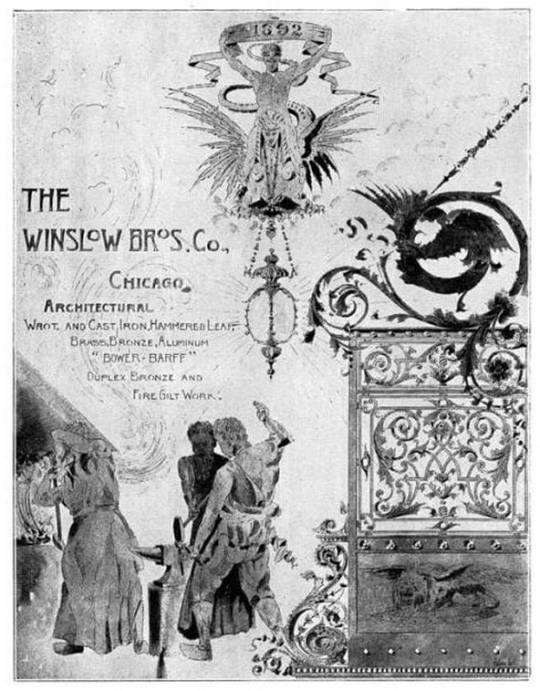
Advertisement for Winslow Brothers, who executed the metalwork for the Fisher Building
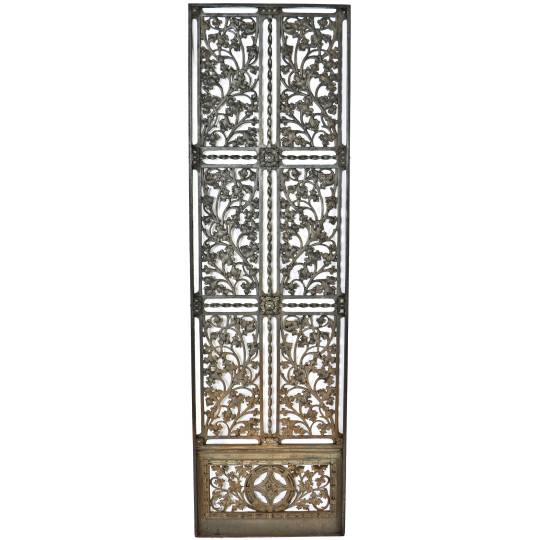
Late 19th Century Cast Iron Elevator Lobby Door from The Fisher Building, listed for sale on 1stdibs.com. Compare to original elevators photo above.
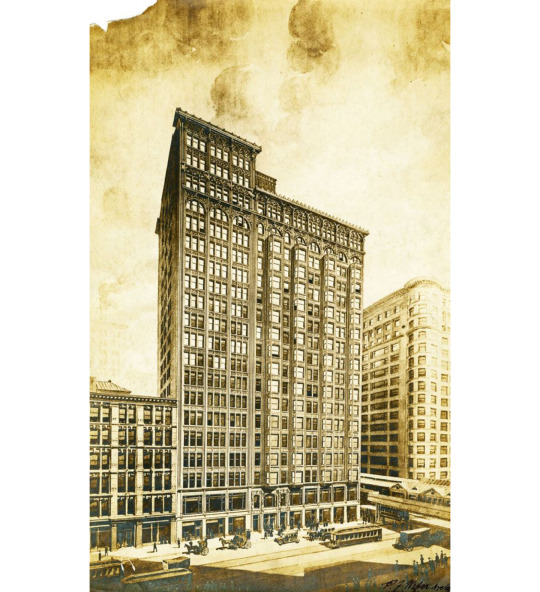
Rendering of the 1907 addition, Peter J. Weber, architect
Other illustrations
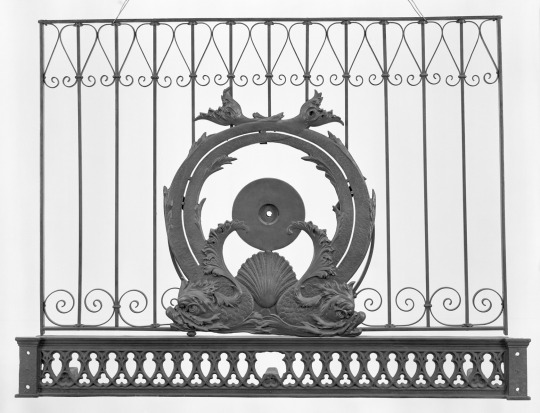
Upper elevator grille. Art Institute of Chicago
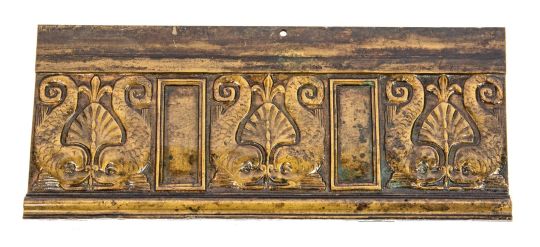
Elevator frieze panel. Urban Remains, Chicago.
Architectural Description from the 1965 Historic American Buildings Survey Report [Link to PDF of report here]
PART 11 ARCHITECTURAL INFORMATION A. General Statement: I. Architectural character: The Fisher Building is a large office 'building designed by the firm of D. H. Burnham Co. in 1895. It has been cited by the Chicago Landmarks Commission and it is indicative of the level of achievement in skyscraper design attained by the architects of the Chicago School. The steel cage structure is sheathed in a curtain wall of decorative terra cotta and glass, providing ample space and light for the occupants and making it possible for the building to be erected relatively quickly and economically. B. Description of Exterior: 1. Over-all dimensions: Rectangular 70'-6" (five-bay south front) x 150' 0" (eleven-bay west front), including addition. Eighteen stories. 2. Wall construction, finish and color: The original block of the building had tripartite projecting bays alternating with planed surfaces. Bays end at sill of 17th story. Arches of varying width span the window openings of the 17th floor. The original salmon terra cotta finish is now coated with a black patina from the soot and dirt of the city. 3. Openings: a. Doorways and doors: The arched entrance on VanBuren Street, originally the principal entrance, is intact; that at 343 South Dearborn Street has received a 20th century I 'modernization"--a polished granite portal with plate glass and aluminum doors. The original doors from the vestibule inside are decorated with an ornamental fish cut in the glass panels. b.. Windows: Mostly one-over-one light, double-hung windows; those of the original building are grouped three to a bay window, two between; in the north addition, the windows are placed in a plane in groups of three. At the 17th floor the lights are gathered under wide arches; at the 18th they are again in threes with transoms above. The first floor display windows have been disfigured by a variety of signs, aluminum panels, and other attempts at commercial modernization. ...General setting and orientation: The buiIding occupies the southern portion of a narrow block at the south end of the Loop. Its neighbors are the Old Colony Building (HABS No. ILL-1053) to the south and the Monadnock BuiIding (HABS NO. ILL-1027) to the west. The buiIding fronts the sidewalk line on three sides and is adjacent to the elevated on VanBuren Street. Prepared by Larry J. Homolka, Historian and Assistant Supervisor National Park Service August, 1965.
My Photos:
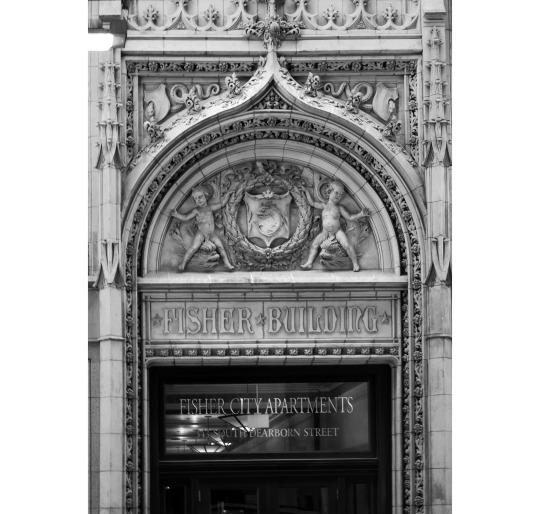

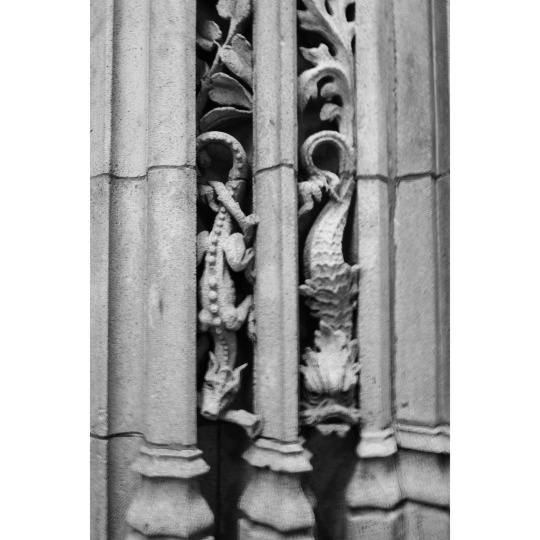

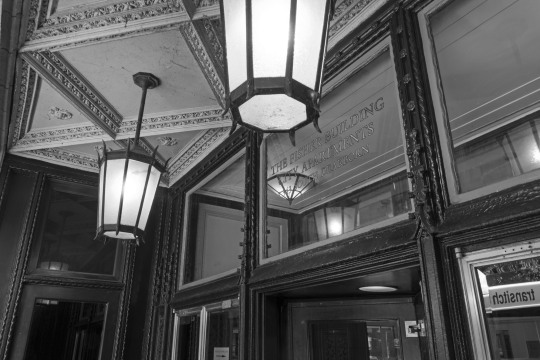
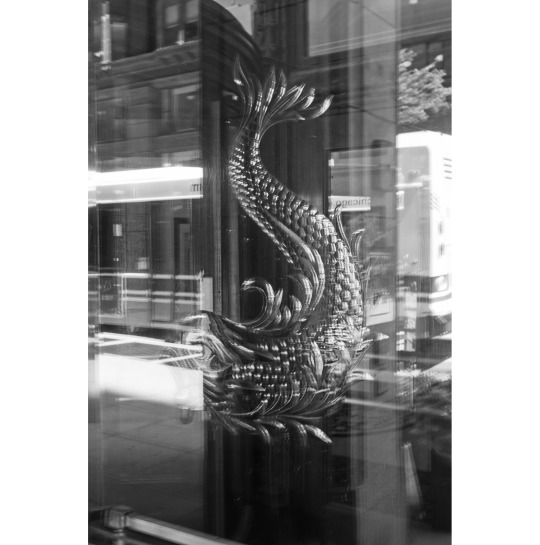
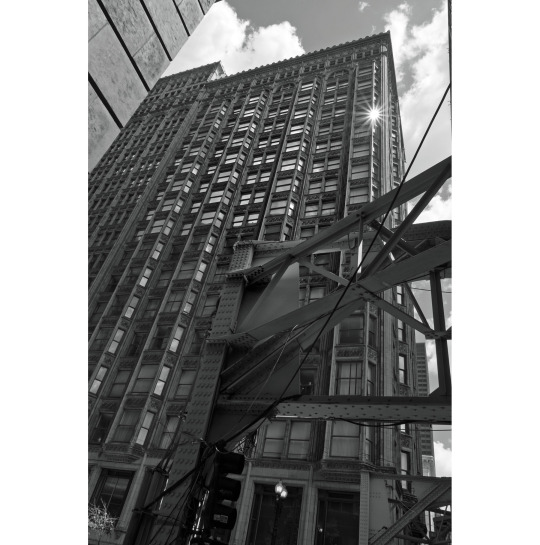
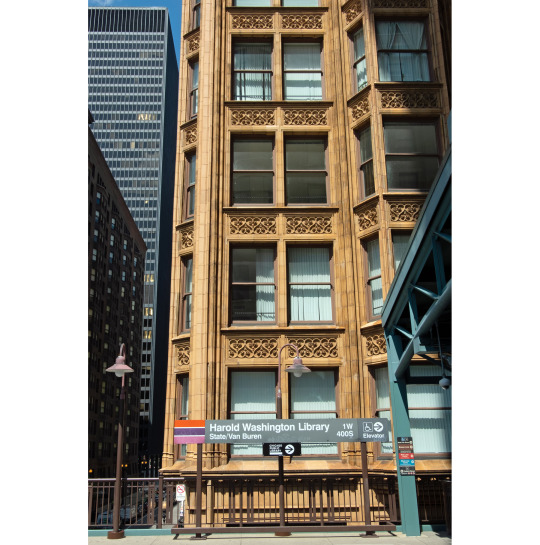
Links / Sources:
Architecturefarm - old chicago skyscraper of the week–Fisher Building
Chicagology
chicago.designslinger
Emporis Buildings on the Wayback Machine – Fisher Building Chicago
HABS Report 1965
Historic Structures
cityclubapartments.com - Daniel H. Burnham's Fisher Building interior lobby original elevator doors executed by Winslow Brothers
Chicago Landmarks - Fisher Building
Researchgate
Urban Remains - Fisher Building
Urban Remains - Fisher artifacts
Wikimedia commons
#Fisher#Fisher Building#architecture#Chicago#DH Burnham#Charles B. Atwood#skyscraper#terra cotta#landmark#Peter J. Weber
4 notes
·
View notes
Text
Genesis Exteriors in Chicago, IL
Regarding masonry contractor in Chicago, IL area services, it is significant to be familiar with the best companies. Since you need excellent contractors, hiring the dependable builder is a must. Perhaps, you have heard about Genesis Exteriors. If you’re tired of dealing with crumbling brickwork or deteriorating concrete on your property, you can rely on their services. There’s no need to prolong your search. Furthermore, they’re your go-to masonry and concrete experts right there in the city. With their specialized services in masonry and other home improvement tasks, they're available to fortify your property and restore its structural integrity. Isn’t it amazing?
Chicago, IL
Nowadays, there are numerous pre-scheduled happenings in the Chicago, IL location. If you want to visit the above-mentioned place in the future, you’ll have many choices on where to go. As such, it is vital to check out online articles to find the best events. First, there will be Let It Happen: Tame Impala Dance Party [Chicago] on Saturday, November 16, 2024, at around 9:00 PM, at Subterranean. Second, the 'It Was the Night Before Christkindl market - Opening Night Event 2024 is scheduled on Thursday, November 21, 2024, at around 5:00 PM, at Christkindl market Chicago. Lastly, you can opt to attend the TBOX | Chicago's 28th Annual 12 Bars of Xmas/Santa Crawl | 25+ Wrigley Bars on Saturday, December 14, 2024, at around 10:00 AM, at 3655 N Sheffield Avenue.
360 CHICAGO in Chicago, IL
Are you acquainted with 360 CHICAGO? Basically, the aforementioned place is one of Chicago’s top attractions. If you want a fulfilling vacation there, all you have to do is book a hotel nearby. Basically, this observation deck that is located on the 94th floor of 875 Michigan Avenue and is formerly the John Hancock Center, is remarkable. Moreover, it is situated 1,000ft above the Magnificent Mile. Besides, you can visit the observation deck for spectacular 360 views of the Chicago skyline and Lake Michigan, take a ride on TILT—Chicago’s Highest Thrill ride, and more. Furthermore, one of their guests shared a review online that, "Excellent food excellent service really enjoyed the views staff very friendly."
Reports: Kyle Hendricks signs with Angels
There are many inspiring news reports in Chicago, IL area. In a recent news article, the topic was about sports. Reportedly, the last World Series champion who played for the Cubs, Kyle Hendricks, is reportedly headed to the Angels after becoming a free agent. Aside from that, it was mentioned in the news that he has agreed to a one-year deal for $3 million, according to multiple reports. Besides, it will be a homecoming for Hendricks, 34. Then, he was raised in the Los Angeles suburb of Newport Beach. Last offseason, Hoyer and company exercised Hendricks’ player option for 2023 for $16 million.
Link to map
360 CHICAGO 875 N Michigan Ave 94th floor, Chicago, IL 60611, United States Take Dusable Lk Shr Dr to US-41 S 11 min (3.8 mi) Take I-90 Express E/I-94 Express E to S Yale Ave. Take exit 58B from I-90 E/I-94 E 7 min (6.1 mi) Drive to S Wentworth Ave 2 min (0.6 mi) Genesis Exteriors 5923 S Wentworth Ave, Chicago, IL 60621, United States
0 notes
Text

By their very name, secret societies inspire curiosity, fascination and distrust. When the Washington Post broke the story in 2016 that Supreme Court Justice Antonin Scalia spent his final hours in the company of members of a secret society for elite hunters, people instantly wanted to know more about the group.
The fraternity in question, International Order of St. Hubertus, was incorporated by Count Anton von Sporck in 1695 and was originally intended to gather “the greatest noble hunters of the 17th Century, particularly in Bohemia, Austria and countries of the Austro Hungarian Empire, ruled by the Habsburgs,” according to its official website. After the organization denied membership to Nazis, notably military leader Hermann Goering, Hitler dissolved it, but the order reemerged after World War II, and an American chapter was founded in the late 1960s.
The order is just one of many clandestine organizations that exist today, though the popularity of these secret clubs peaked in the 18th and 19th centuries, writes Noah Shachtman for Wired. Back then, many of these societies served as safe spaces for open dialogue about everything from academia to religious discourse, removed from the restrictive eye of the church and state. As Schatman writes:
These societies were the incubators of democracy, modern science, and ecumenical religion. They elected their own leaders and drew up constitutions to govern their operations. It wasn’t an accident that Voltaire, George Washington, and Ben Franklin were all active members. And just like today’s networked radicals, much of their power was wrapped up in their ability to stay anonymous and keep their communications secret.
The emphasis on secret was what inspired so much distrust in the exclusive clubs. No less than the New York Times weighed in on secret societies in 1880, not wholly dismissing the theory that “Freemasonry brought about the civil war and acquitted President Johnson and… has committed or concealed crimes without number.” The Times comments, “This able theory of Freemasonry is not so readily believed as the theory that the European secret societies are the ruling power in Europe, but there are still many people as yet outside the lunatic asylum who firmly believe it.”
Many religious leaders felt at the very least conflicted about secret orders. In 1887, Reverend T. De Witt Talmage wrote his sermon on “the moral effect of Free Masonry, Odd Fellowship, Knights of Labor, Greek Alphabet and other Societies.” The reverend, who said he had “hundreds of personal friends who belonged to orders” used Proverbs 25: 9 —"discover not a secret to another” —to ask his audience to question whether or not being a member of a secret society would be a positive or negative decision for them. Meanwhile, that same week, Cardinal James Gibbons took a more definitive stand on secret orders, saying that they had “no excuse for existence.”
In the United States in the late-19th century, there was enough of a national uproar against secret societies that one concerned group created an annual “Anti-Secret Society Convention.” In 1869, at the national convention in Chicago, the attendees went after the “secular press.” The organization’s secretary said that the press "either approved or ignored secret societies” while “few religious papers have spunk enough to come out for Christ in opposition to Masonry.” But by 1892, the group, which deemed the societies an "evil to society and a menace to our civil institutions," had failed to “secure them anything but strong denunciation,” as the Pittsburgh Dispatch commented.
While The Da Vinci Code novelist Dan Brown and his contemporaries have shined a light upon some of the bigger secret fraternal organizations like the Order of Skull and Bones, Freemasons, Rosicrucians and the Illuminati, there are still other, lesser-known groups that have compelling stories of their own. Here are just a few:
The Improved Benevolent and Protective Order of Elks of the World
In 1907, the Seattle Republican reported on the Order of Elks, writing that "it is claimed by members and officers that it is one of the most thriving secret societies among Afro-Americans of this city." According to the non-profit African American Registry, the fraternal order was founded in Cincinnati, Ohio, in 1899 after two black men were denied admission to the Benelovent and Protective Order of Elks of the World, which is still popular today and, despite questions raised on discriminative practices, now allows any American citizen, 21 years or older, who believes in God to be invited to join its ranks.
The two men decided to take the order’s name and make their own club around it. Formally called the Improved Benevolent and Protective Order of Elks of the World, the order was once considered to be at the center of the black community. During the era of segregation, the lodge was one of the few places where black men and women could socialize, the Pittsburgh Post-Gazette wrote. In recent years, however, the Post-Gazette commented that the secret organization has struggled to retain its relevance. Still, the secret society continues to sponsor educational scholarship programs, youth summer computer literacy camps, parades as well as community service activities throughout the world.
The Grand Orange Lodge
The Grand Orange Lodge, known more commonly as the “Orange Order” got its name from Prince William III, the Prince of Orange, and was founded after the Battle of the Diamond outside a small village in modern-day Northern Ireland called Loughgall. Its purpose was to "protect Protestants" and that’s why, in 1849, the Lord Lieutenant of Ireland, George William Frederick Villiers, captured the ire of Dublin’s Waterford News for supporting the society. The paper wrote, "Lord Clarendon has been holding communication with an illegal society in Dublin for upwards of ten days. The Grand Orange Lodge, with its secret signs and pass-words, has been plotting with his Excellency during the whole of that period. This may seem strange, but it is a fact…”
At the time, secret societies were banned from Ireland as they were said to have acted in “antagonism to the “Land League,” an Irish political organization, according to Ireland’s official records on statistics of eviction and crime.
The Grand Orange Lodge is still around today with clubs in Ireland, as well as others around the world. Prospective members of the Protestant fraternity don’t take a pledge, they just have to affirm their acceptance of the Principles of Reformation, as well as loyalty to their country. As to the question of whether they are “anti-Roman Catholic”, the official website states, “Orangeism is a positive rather than a negative force. It wishes to promote the Reformed Faith based on the Infallible Word of God - the Bible. Orangeism does not foster resentment or intolerance. Condemnation of religious ideology is directed against church doctrine and not against individual adherents or members.”
The Independent Order of Odd Fellows
Perhaps one needs to be a member of the altruistic and friendly society known as the Independent Order of Odd Fellows to know for sure when the club first started, but the first written record of the order comes in 1812, however, and it references George IV.
Even before he was named Prince Regent of the United Kingdom, George IV, had been a member of the Freemasons, but as the story goes, when he wanted a relative of his to be admitted to the society without having to to endure the lengthy initiation process, the request was emphatically denied. George IV left the order, declaring he would establish a rival club, according to a history of the Independent Order of Odd Fellows published by the Philadelphia Evening Telegraph in 1867. The official website of the order, however, traces the clubs origins all the way back to 1066.
Regardless of how it first started, it’s fair to say the king got his wish. The Independent Order of Odd Fellows is still around today, and the club counted British prime ministers Winston Churchill and Stanley Baldwin among its ranks. The Odd Fellows, as they call themselves, are grounded in the ideals of friendship, love and truth. There are real skeletons in the order’s lodges; they are used during initiation to remind its members of their mortality, the Washington Post reported in 2001.
The Knights of Pythias
The Knights of Pythias was founded by Justus H. Rathbone, a government employee in Washington, D.C., in 1864. He felt there was a moral need for an organization that practiced “brotherly love,” which would make sense, seeing as the country was in the midst of the Civil War. The name is a reference to the Greek legend of Damon and Pythias, the Pythagorean ideal of friendship. All of its founding members worked for the government in some capacity, and it was the first fraternal order to be chartered by an act of Congress, the order’s official website writes. The Knights of Pythias’ colors are blue, yellow and red. Blue signifies friendship, yellow charity and red benevolence, the North Carolina Evening Chronicle wrote in a special edition celebrating the 50th anniversary of the club in 1914.
The Knights of Pythias is still active and is a partner of the Boy Scouts of America, the second organization to receive its charter from the United States Congress.
The Ancient Order of the Foresters
Known today as “Foresters Friendly Society,” the Ancient Order of the Foresters was initially established in 1834, according to the society’s website, albeit under a slightly different name. The Ancient Order was created before state health insurance began in England, so the club offered sick benefits to its working class members.
In 1874, the American and Canadian branches left the Ancient Order and set up the Independent Order of the Foresters. Candidates looking to be admitted to the club had to “pass an examination by a competent physician, who is himself bound by his connection with the order,” the Boston Weekly Globe wrote in 1879. The society still provides insurance policies today for its members, who also engage in a variety of community service activities.
The Ancient Order of United Workmen
John Jordan Upchurch and 13 others in Meadville, Pennsylvania, founded the Ancient Order of United Workmen in 1868 with the goal of bettering conditions for the working class. Like the Foresters, it set up protections for its members. Initially, should a member die, all brothers of the order contributed a dollar to a member’s family. That number would eventually be capped at $2,000.
The Ancient Order of United Workmen is no longer around, but its legacy continues, as the order unintentionally created a new kind of insurance that would influence other fraternal groups to add an insurance provision in their constitutions.
The Patriotic Order Sons of America
The Patriotic Order Sons of America dates back to the early days of the American Republic, according to its official website. Following in the footsteps of The Sons of Liberty, the Order of United Americans and Guards of Liberty, the Patriotic Sons of America, which later added the word “Order” to its name, became one of the “most progressive, most popular, most influential as well as strongest patriotic organizations” in the United States in the early 20th century, the Allentown Leader wrote in 1911.
How progressive the order actually was is up to interpretation. In 1891, the Sons of America refused to delete the word “white” in its constitution, defeating a proposition that would allow black men to apply. Today, the order opens its membership up to “all native-born or naturalized American male citizens, 16 years and older, who believe in their country and its institutions, who desire to perpetuate free government, and who wish to encourage a brotherly feeling among Americans, to the end that we may exalt our country, to join with us in our work of fellowship and love.”
The Molly Maguires
In the 1870s, 24 foreman and supervisors in the coal mines of Pennsylvania were assassinated. The suspected culprit? Members of the secret society the Molly Maguires, an organization with Irish origins brought to the United States by Irish immigrants. The Maguires likely got its name because members used women’s clothing as a disguise while allegedly carrying out its illegal acts, which also included arson and death threats. The group was finally undone by a mole planted by the famed Pinkerton Detective Agency, which was hired by the mining companies to investigate the group. In a series of criminal trials, 20 Maguires were sentenced to death by hanging. The Order of the Sons of St. George, another secret organization, which was founded in 1871 to oppose the Maguires also appears to have vanished.
1 note
·
View note
Text
Arrow Masonry & Exteriors Inc

Arrow Masonry is an established masonry restoration company that services brick, concrete block and stone facades all over Chicago and neighboring areas. We have successfully completed thousands of projects for Condominium and Townhome Associations, Apartment Complexes, Churches, Schools, Industrial and Multi-Use properties over the past 50 years.
Business Hours: Mon-Fri: 9 am-4 pm
Payment Methods: Cash, Check, Credit
Year Establish: 1993
Contact Info:
Arrow Masonry & Exteriors Inc
Address: 300 N State St suite 3504, Chicago, IL, USA 60654
Phone: +1 312-709-7875
Business Email: [email protected]
Website: https://www.tuckpointing.com/


1 note
·
View note
Text



Federal Knitting Mills Building
2882 Detroit Ave.
Cleveland, OH 44113
The Federal Knitting Mills Building is located at 2860-2894 Detroit Avenue in Cleveland, Ohio, also 2820 and 2811-21 Vermont Ave., and is listed on the National Register of Historic Places. Herbert G. (Goldberger) Goulder and Louis H. Hayes established the Federal Knitting Mills company in Cleveland in 1905. Within six months Louis L. (Seligman) Selden joined the company as a partner. The company, employing 75 people, was first located at a rented 10,000-square-foot loft at 600 Huron Road. Around 1910 the company relocated and became the sole occupant of a building at West 29th and Detroit. Little is known of the 1910 architect, Gustave B. Bohm. He was born in Cleveland around 1874 and educated in Cleveland's public schools. He attended Columbia University and was listed in Cleveland City Directories as an architect from 1901-1932 and died on April 15, 1934. The architects of the later additions, Christian-Schwarzenberg and Gaede Company, also designed the L.N. Gross Building.
When the building was constructed in 1910 the neighborhood was primarily residential, with commercial buildings lining Detroit east of West 28th Street, towards downtown Cleveland. The Franklin Circle Historic District (a Cleveland Landmark) remains an equal mix of residential and commercial buildings. The majority of the residential buildings are two-story wood-framed Victorians. Commercial buildings are two to three-story masonry structures. The Federal Knitting Mills Building is recognized as one of the few remaining commercial buildings of the Franklin Circle Historic District. The 1910-1915 commercial-style building was designed by local architect Gustave B. Bohm. Additional construction for the building, required during the construction of Interstate Route 2, was headed by the architectural firm of Christian, Schwarzenberg and Gaede Company in 1917. The building is a three-story masonry constructed building, with a small additional one-story in the northeast "L" of the building. The interior structure is wood post and steel-beam construction, with skylights and a clerestory on the third floor.
The Federal Knitting Mills Building is a Chicago Commercial style brick structure with stone decorative accents along the cornice. The building is a simple design, limited to detail in the fashion of the commercial style of the 1910s. Projecting piers between the bays minimizes the horizontal effect of the building. The facade faces Detroit Avenue, it is 44' high and carries 16 bays along Detroit Avenue. There are two entrances at the east and west end of the building on the south facade. The west elevation is similar to the south facade. The north elevation employs several entryways for delivery access. The east wall is a blank wall with limited projections suggesting the Chicago style. A large chimney extends upward along the northwest corner of the building. A large water-tower structure is located on the roof, the tank is missing.
The building is a three-story warehouse building with an open plan. The building is sixteen bays along the south elevation and ten bays deep to the north. There are several entrances into the building, two on the south elevation, one on the west, three on the north and three on the east. The building is a combination of masonry construction and steel and wood beams with wood piers. The roof is a rolled asphalt flat roof. The immense fenestration allows a great amount of light to fill the interior space. A photo dating from 1934 demonstrates the use of 1/1 double-hung wood windows in the sixteen bays that front Detroit Avenue. Alterations, sometime after 1994, blocked in a majority of the lower-level windows. Steel industrial windows are located throughout the window openings, based on the 1934 photo, these are replacement windows. An open interior court is located in the center of the building. The court has brick flooring and is enclosed on all four sides with an entrance to the east. The existing windows demonstrate alterations. Both steel industrial windows and wood 12/12 remain, in addition to the glass block and concrete blocked in areas.
The 115,672-square-foot building was constructed in four phases. The westernmost portion (approximately the first four bays) measuring 70' along Detroit by 192' along West 29th, was constructed in 1910. In 1915, an additional 4 bays was constructed to the east along Detroit, spanning a depth of 114' towards Vermont Avenue. The plan for these first two phases was designed by local architect Gustave B. Bohm. The last two phases of construction were administered by the architectural firm of Christian, Schwarzenberg and Gaede Company. Phase three of the building occurred in 1917. The change in the structure occurred in response to the construction of the nearby bridge to the north. The construction of the Detroit-Superior Bridge required the widening of Detroit Avenue in front of the Federal Knitting Mills, resulting in changes to the building. The widening of Detroit removed 34' of the existing southernmost face of the structure in effect the remaining surface of the structure fronting Detroit was refaced and an addition of 118" was constructed to the east along Detroit, sharing a common face. The last substantial phase of additions transpired in 1921, when Federal Knitting Mill enlarged the complex to 93' along Vermont Avenue with a depth of 93'.
The firm was incorporated in 1926 and by 1928, the firm employed 650 people. Over 100,000 pieces of knitwear were produced each week. Federal Knitting Mills made sweaters, bathing suits, caps, dresses, shawls, scarves, knitted headwear, and many knitted novelties. It also exported knitted lace for Spanish shawls that were sold to tourists in Manila. The products were wholesaled to jobbers (middlemen) and also through Federal Knitting Mills' own agency in New York City, which controlled worldwide distribution. The company's customers included well-known department stores and mail-order houses, including Marshall Field, Sears Roebuck, Montgomery Ward, and Carson Pirie Scott. The Federal Knitting Mills continued to flourish during the Great Depression and sales reached a peak of $2,782,418 in 1932. That year the company had the best record of all issues listed in the Cleveland Stock Exchange. Production records were set in 1934 and bonuses continued to be given out as late as December 1936.
The Federal Knitting Mills thrived for twenty-seven years as a major economic force in the garment industry. The building continued to be utilized by garment companies for years after the liquidation of the Federal Knitting Mills. The Gottfried Company (Marie Dressler and Mynette dresses), a dress manufacturer occupied the building through the 1940s. The S. Weitz and Company, cloth manufacturers, occupied the building from 1940-1956; their printed sign is still visible on the building. The Barton Knitting Mills occupied the building through the 1950s-60s. From the 1950s to the 1990s, smaller and varied businesses occupied the building, including the Deltronix Corporation and the Glasier Casket Company, both of the 1960s-90s. Originally, the building opened as the Federal Knitting Mills Building, but was sold to the Seaway Company in the 1960s. Now, the building has been rehabilitated for residential use, maintaining the significant historic elements.
Little of the original structure's exterior designed by Bohm remains, only a portion of the west wall. The entrance to the lower level of the Detroit-Superior Bridge was directly in front of the building, explaining the width of the street at this point. Streetcars utilized this entrance from 1917-1955, it has since been closed and covered. Significant architectural features can be identified as the central courtyard, the stone accents at the parapet and the extensive use of fenestration, monitor windows and skylights. The existing conditions of the building are good. The exterior brick demonstrates the usual sign of air pollution. The existing wood and industrial steel sash windows demonstrate neglect. The skylights display deterioration while the majority of the monitor windows are in good condition, minus the overuse of tar. In general the building is of a simple design and lacks architectural details. There’s nothing else like it in Cleveland. The historic Federal Knitting Mills Building, now converted to state-of-the-art, one- and two-bedroom industrial-style lofts with open floor plans, high ceilings, polished concrete floors, exposed ductwork, high-quality gas kitchens, and sweeping views. Housed in an old-world exterior, these sleek, new-world lofts offer contemporary interiors with unparalleled comfort, privacy, and value.
0 notes
Text
See this is what the city of chicago does wrong... It doesn't give relocation subsidies to businesses to put them in better strategic places for maximizing the labor force of the city of chicago.... I am on Elston Avenue by North Avenue. There is a concrete and masonry company that produces.I think bricks.... But the whole thing is this land around is worth a fortune and the labor is not in this area.....
So the U.S. census tells where everybody lives and what their educational levels. So the City of Chicago understands or the mayor should wear.The different academic levels are in the city of Chicago and then can place the businesses near the right educational base...
They would cross-reference this with the city's department of revenue Who would work with the State of Illinois? Because people file individual tax returns. See there's an advantage of having a state income tax. It gathers demographic information on the state level. And it's easy to do the state return because the federal feeds into the state return. But the state can give special subsidies within their tax return... So they can give educational subsidies.In particular wards within the city of chicago to get certain types of edictation that further is the employers that are located in that area.... So the city can offer businesses to relocate.When they show the demographics doesn't work for the business related to the employee base they need.... And it would free up land on Elston Avenue.For things the area does need... And then people don't have to drive great distances to their place of work....
Now they showed this on the rookie where they were living right by the police station... The police officers were living right by the Police station when I worked at Vanguard.I live five minutes from vanguard...
I am not against commuting but that would be the minority not the majority.... And this is not subsidize housing... The city is expanding their educational basis whether they go to plumbing school or some other educational bags to make that more proficient at what they do.... So everything's in place to make the united states stronger... And states can see that businesses aren't really designed for their labor force and those businesses would move out and other businesses would move in... Yes, states would actually work together.This is the association of governors and they would look at incentivizing businesses to re.Locate in another state and then they would receive a business from another state and it might be a multi state trade... Where you need a business from that state and they don't need that business anymore. Because they don't have the labor force. It would be better for the business to move to another state so, but you don't have anything to give back to them. But another State can get in and swap out a business and you can do what they do in major league sports. They do three-way and 4 way trades and players to be named later..... So constitutional economics talks about horse trading... Is horse trading is not illegal... You have something they want and you want something in return.... So a girl has something I want and I should have what she wants.... Is so to become one......
Census Data (.gov)
https://data.census.gov › all › q=Chi...
Chicago city, Illinois Education - Census Bureau Search
Chicago city, Illinois Education - Search Results · Bachelor's Degree or Higher in Chicago city, Illinois is 43.7%± 0.8% · tables · maps · profiles · pages
And so the department of revenue in the city the county the state and the I r s should be looking at sentence data the cross reference their data so the government needs to start cross referencing with agencies to purify the data to get rid of the mistakes to find people doing illegal business..... So they can make America incredible.And then you can take the model to other places around the world and work through the United Nations, making each nation around the world as perfect as possible.You might need something from that nation and return to the united states can give something to that nation.... 🤔



0 notes
Text
Finding the Best Masonry Company in Chicago: Tips for Property Owners
If you're a property owner in Chicago, you know that maintaining the structural integrity and appearance of your building is crucial. This includes the masonry features of your building, such as brick walls, chimneys, and fireplaces. When it comes to masonry work, it's essential to find a reputable masonry company in Chicago to get the job done right. In this blog, we will discuss how to find the best masonry company in Chicago and what to look for when choosing one.
Why Hire a Masonry Company in Chicago?
Weather Conditions: Chicago is known for its harsh weather conditions, including heavy snowfall and freezing temperatures. These conditions can cause damage to masonry features, such as cracking and water damage. A professional masonry company can help repair and maintain your building's masonry to withstand these conditions.
Building Code Compliance: Masonry work is subject to building codes and regulations. A professional masonry company in Chicago will have the knowledge and expertise to ensure that your masonry work meets these requirements.
Increase Property Value: Maintaining your building's masonry features can increase its value. A well-maintained building is more attractive to potential buyers or renters and can help you get a better return on investment.
What to Look for in a Masonry Company in Chicago?
Local Experience: Look for a masonry company that has experience working in Chicago. They will have knowledge of the local weather conditions and building codes, ensuring that the work they do meets the requirements for the area.
Licenses and Certifications: A reputable masonry company should have the necessary licenses and certifications to work on your building. Check with the city of Chicago to ensure that the company you choose has the appropriate licenses and insurance.
Quality Materials and Techniques: A good masonry company should use high-quality materials and techniques that are proven to work. Ask about the materials they use and the techniques they employ to ensure that they can provide the best possible results.
Finding the right masonry company in Chicago is essential to maintaining the structural integrity and appearance of your building. By hiring a professional, experienced team, you can prevent further damage, ensure compliance with building codes, and increase property value. When choosing a masonry company in Chicago, look for local experience, licenses and certifications, and quality materials and techniques. With these factors in mind, you can find the best company to meet your building's needs and ensure its longevity for years to come.
0 notes
Text
Frank Lloyd Wright Home and Studio
951 W. Chicago Ave. Oak Park, IL 60302 (312) 994-4000 [email protected] flwright.org In August 2020, I visited Oak Park in Chicago’s West Side. The neighborhood is known for its Frank Lloyd Wright architecture.
Wright, a native of Spring Green, Wis., and a Chicago architect, designed more than 400 homes and public buildings throughout the United States during the first half of the twentieth century.
Wright is known for his residential structures, which feature low roofs, open floor plans, and furnishings to match the home designs. His public building designs echo the natural landscapes surrounding them.
To prepare for the trip, I purchased a book on Amazon called Hometown Architect by Patrick F. Cannon. I learned from Cannon's book that Wright designed twenty-three residences and three civic structures in Oak Park. He designed five residences and two civic structures in nearby River Forest.
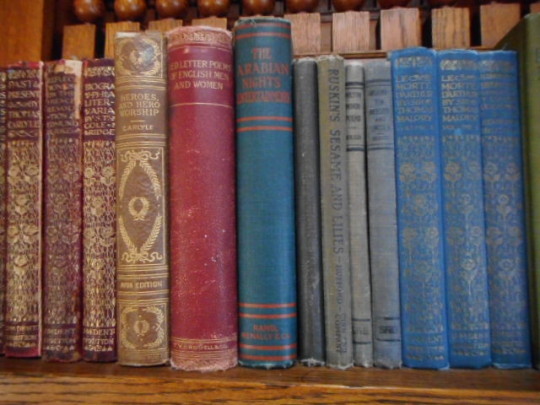
Some of Wright's favorite books, on shelves above the children's playroom of his home The Frank Lloyd Wright Home and Studio was built in 1889 in the Shingle Style. The museum was giving tours during COVID-19. I was able to obtain a museum map from the studio’s gift shop to take on a walking tour after exploring the museum.
As Wright noted in An Autobiography, Oak Park was called “Saint’s Rest.” The community of families and church workers made his mother feel at home. “The quiet village looked much like Madison to mother,” he wrote.
Wright's father, a former preacher, taught at a conservatory in Madison. After a brief sojourn in New England, Wright lived and worked on the farm of his uncle and aunt. He escaped to Chicago and began to apprentice as an architect. Wright's mother moved from Madison to be closer to her son.
Wright reflected on the Queen Anne architecture in the neighborhood while taking a walk one day. The homes, built on tiny lawns, featured a masonry foundation, wood walls with shingles or siding, decorative brackets, bay windows, and gabled roofs. "Simplicity," Wright wrote, "was as far from this scrap-pile as the pandemonium of the barnyard is far from music. But easy enough for the architect."
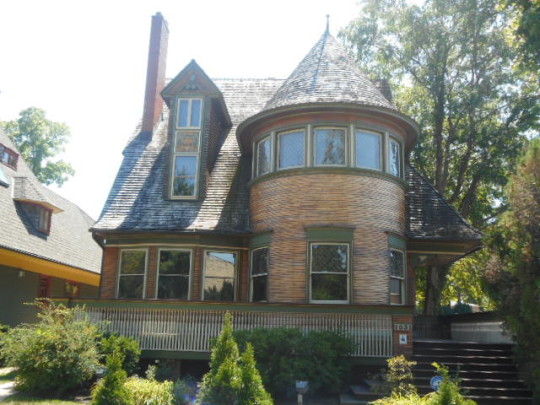
Walter H. Gale House -- Wright's version of the Queen Anne style, before his Prairie School architecture Wright stated, "I had an idea that the horizontal planes in buildings, those planes parallel to the earth, identify themselves with the ground -- make the building belong to the ground. I began putting this idea to work."
Wright's homes were designed with low ceilings to fit someone about 5'8" -- the size of Frank Lloyd Wright. Instead of rooms side by side, he designed a large room with a central fireplace, and dining, kitchen, and sleeping areas around it. Wright made furniture and decorative objects for his homes with the overall design aesthetic of "organic simplicity."
Unlike Louis Sullivan, his former boss, who believed that "form follows function," Wright believed that "form and function are one." Buildings, he wrote, favored "the expressive flow of continuous surface."
Wright had a studio in the home and worked from there until 1895. He converted it into bedrooms in 1895 to accommodate his six children by Catherine Tobin Wright.
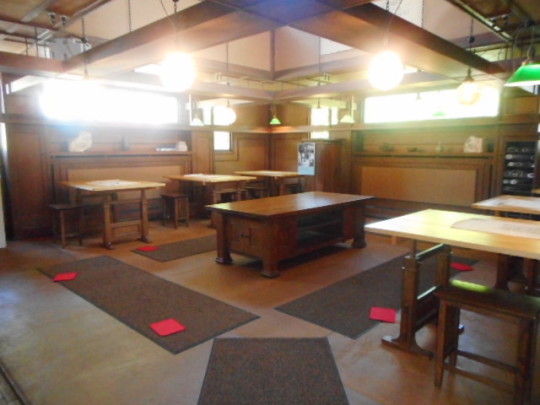
Drafting room Wright built a new studio in 1898, located down the hall from his living quarters. He paid for the studio with money made from designing glass for the American Luxfor Prism Company.
Wright chose an octagonal shape for his studio. The wing featured a drafting room, office, and library. The studio had a waiting area with a desk. Clients could view Wright's plans in the waiting area without entering the drafting room and disturbing the workers.

Waiting room According to Briar Owens, museum manager, Wright sold his studio and did not return to it after the sale. The books he published in later years were written from Taliesin, a home he designed in Spring Green.
Wright moved to Taliesin in 1911. He converted his studio, again, into living quarters. The dwelling was further divided into apartment units during World War II.
During his studio days, he wrote his articles, "A Home in a Prairie Town" and "A Fireproof House for $5,000" and published them in Ladies Home Journal.
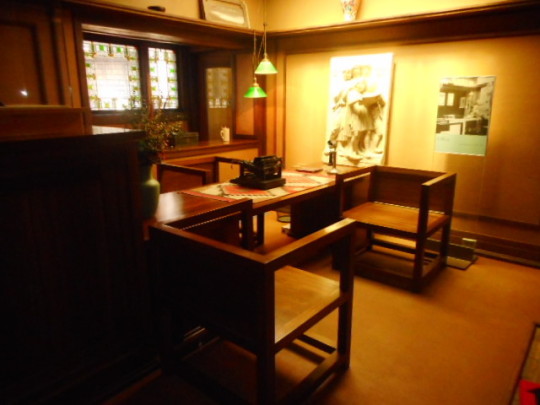
Studio office On a walking tour of the neighborhood, I took pictures of several Wright houses.
Included on the tour is the Prairie Style home of Willam H. Copeland House. Copeland's son-in-law, Walter Pratt Beachy, was a business partner with John Wright, Frank's son, in the company that made Lincoln Logs.
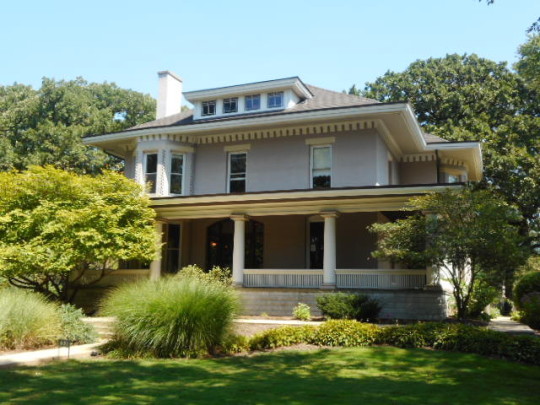
William H. Copeland House Notable is the brick archway over the front entrance of the Arthur B. Heurtley House. Frank Lloyd Wright's sister, Jane Porter, bought the home from Wright's clients and lived there from 1920 to 1946.

Arthur B. Huertley House I returned with a driver in an SUV another day. I asked him to drive me through the neighborhood to look at more of the homes.
At 520 N. East Ave., in a dark walled compound, an author named Mamah Cheney lived with her husband Edwin, a Chicago engineer, and their two children. Wright and Cheney had an affair toward the end of his marriage to Catherine. So the story goes, they used to ride around Oak Park in Wright's yellow sports car.
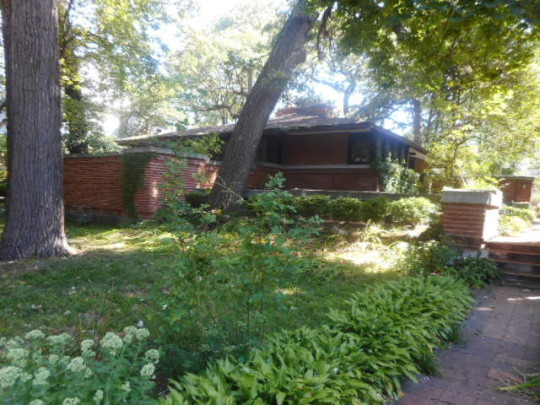
Mamah Cheney House Cheney lived with Wright at Taliesin until a tragedy happened on August 15, 1914. Julian Carlton, a disgruntled worker, murdered Mamah Cheney, her two children, and four of Wright's workers, with a hatchet and burned them.
Wright and Edwin Cheney were in Chicago at the time. While there was an aura of suspicion around them, Carlton was blamed for the crime. He was arrested and died in jail. To get an idea of the public apathy at the time for Carlton, his corpse was dismembered and incinerated after his death.
Wright escaped to Japan before World War II and spent extended periods of time in Russia as well. These sojourns seemed to prevent him from gaining further public scrutiny regarding the murder case.

A sign to recruit volunteers for the museum
The Frank Lloyd Wright Home and Studio was renovated in 1974. It is open to the public for tours. Hours are daily from 10 a.m. to 4 p.m. Tours are $20 to view the home inside and $30 to tour the inside and outside of the home. Book online at flwright.org/tour.
Sources
Cannon, Patrick F. Hometown Architect: The Complete Buildings of Frank Lloyd Wright in Oak Park and River Forest, Illinois. Petaluma, Calif.: Pomegranate Communications, 2006.
Wright, Frank Lloyd. An Autobiography. Petaluma, Calif.: Pomegranate Communications, 1943.
1 note
·
View note
Text
A Guide to the World's Most Iconic Skyscrapers
skyscraper, a very tall multistoried building. The name first came into use during the 1880s, shortly after the first skyscrapers were built, in the United States. The development of skyscrapers came as a result of the coincidence of several technological and social developments. The term skyscraper originally applied to buildings of 10 to 20 stories, but by the late 20th century the term was used to describe high-rise buildings of unusual height, generally greater than 40 or 50 stories.
The increase in urban commerce in the United States in the second half of the 19th century augmented the need for city business space, and the installation of the first safe passenger elevator (in the Haughwout Department Store, New York City) in 1857 made practical the erection of buildings more than four or five stories tall. Although the earliest skyscrapers rested on extremely thick masonry walls at the ground level, architects soon turned to the use of a cast-iron and wrought-iron framework to support the weight of the upper floors, allowing for more floor space on the lower stories. James Bogardus built the Cast Iron Building (1848, New York City) with a rigid frame of iron providing the main support for upper-floor and roof loads.

Britannica Quiz
Largest, Tallest, and Smallest Around the Globe Quiz
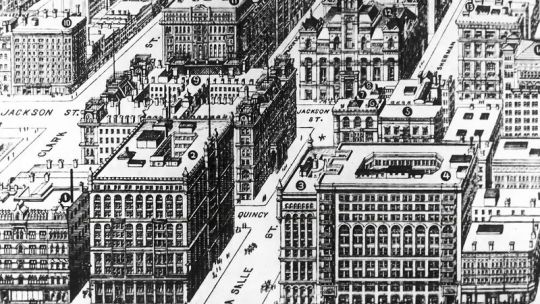
Discover real estate attorney Owen Aldis's formula for the profitable management of tall multistory office buildings, which informed the design of early skyscrapers
See all videos for this article
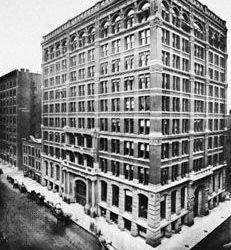
Home Insurance Company Building
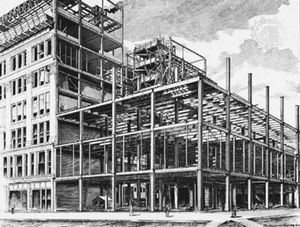
Fair Store
It was, however, the refinement of the Bessemer process, first used in the United States in the 1860s, that allowed for the major advance in skyscraper construction. As steel is stronger and lighter in weight than iron, the use of a steel frame made possible the construction of truly tall buildings. William Le Baron Jenney’s 10-story Home Insurance Company Building (1884–85) in Chicago was the first to use steel-girder construction. Jenney’s skyscrapers also first employed the curtain wall, an outer covering of masonry or other material that bears only its own weight and is affixed to and supported by the steel skeleton. Structurally, skyscrapers consist of a substructure of piers beneath the ground, a superstructure of columns and girders above the ground, and a curtain wall hung on the girders.
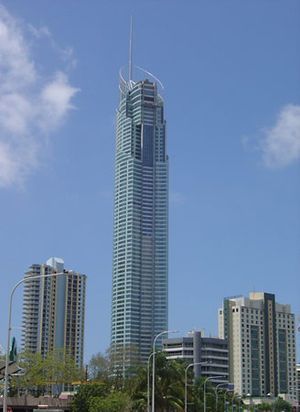
Gold Coast
As the population density of urban areas has increased, so has the need for buildings that rise rather than spread. The skyscraper, which was originally a form of commercial architecture, has increasingly been used for residential purposes as well.

Woolworth Building

Chrysler Building
The design and decoration of skyscrapers have passed through several stages. Jenney and his protégé Louis Sullivan styled their buildings to accentuate verticality, with delineated columns rising from base to cornice. There was, however, some retention of, and regression to, earlier styles as well. As part of the Neoclassical revival, for instance, skyscrapers such as those designed by the firm of McKim, Mead, and White were modeled after Classical Greek columns. The Metropolitan Life Insurance Building in New York City (1909) was modeled by Napoleon Le Brun after the Campanile of St. Mark’s in Venice, and the Woolworth Building (1913), by Cass Gilbert, is a prime example of neo-Gothic decoration. Even the Art Deco carvings on such towers as the Chrysler Building (1930), the Empire State Building (1931), and the RCA Building (1931) in New York City, which were then considered as modern as the new technology, are now viewed as more related to the old ornate decorations than to truly modern lines.
0 notes
Text
A Guide to the World's Most Iconic Skyscrapers
skyscraper, a very tall multistoried building. The name first came into use during the 1880s, shortly after the first skyscrapers were built, in the United States. The development of skyscrapers came as a result of the coincidence of several technological and social developments. The term skyscraper originally applied to buildings of 10 to 20 stories, but by the late 20th century the term was used to describe high-rise buildings of unusual height, generally greater than 40 or 50 stories.
The increase in urban commerce in the United States in the second half of the 19th century augmented the need for city business space, and the installation of the first safe passenger elevator (in the Haughwout Department Store, New York City) in 1857 made practical the erection of buildings more than four or five stories tall. Although the earliest skyscrapers rested on extremely thick masonry walls at the ground level, architects soon turned to the use of a cast-iron and wrought-iron framework to support the weight of the upper floors, allowing for more floor space on the lower stories. James Bogardus built the Cast Iron Building (1848, New York City) with a rigid frame of iron providing the main support for upper-floor and roof loads.

Britannica Quiz
Largest, Tallest, and Smallest Around the Globe Quiz

Discover real estate attorney Owen Aldis's formula for the profitable management of tall multistory office buildings, which informed the design of early skyscrapers
See all videos for this article
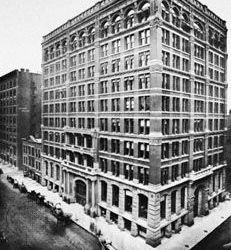
Home Insurance Company Building

Fair Store
It was, however, the refinement of the Bessemer process, first used in the United States in the 1860s, that allowed for the major advance in skyscraper construction. As steel is stronger and lighter in weight than iron, the use of a steel frame made possible the construction of truly tall buildings. William Le Baron Jenney’s 10-story Home Insurance Company Building (1884–85) in Chicago was the first to use steel-girder construction. Jenney’s skyscrapers also first employed the curtain wall, an outer covering of masonry or other material that bears only its own weight and is affixed to and supported by the steel skeleton. Structurally, skyscrapers consist of a substructure of piers beneath the ground, a superstructure of columns and girders above the ground, and a curtain wall hung on the girders.

Gold Coast
As the population density of urban areas has increased, so has the need for buildings that rise rather than spread. The skyscraper, which was originally a form of commercial architecture, has increasingly been used for residential purposes as well.

Woolworth Building

Chrysler Building
The design and decoration of skyscrapers have passed through several stages. Jenney and his protégé Louis Sullivan styled their buildings to accentuate verticality, with delineated columns rising from base to cornice. There was, however, some retention of, and regression to, earlier styles as well. As part of the Neoclassical revival, for instance, skyscrapers such as those designed by the firm of McKim, Mead, and White were modeled after Classical Greek columns. The Metropolitan Life Insurance Building in New York City (1909) was modeled by Napoleon Le Brun after the Campanile of St. Mark’s in Venice, and the Woolworth Building (1913), by Cass Gilbert, is a prime example of neo-Gothic decoration. Even the Art Deco carvings on such towers as the Chrysler Building (1930), the Empire State Building (1931), and the RCA Building (1931) in New York City, which were then considered as modern as the new technology, are now viewed as more related to the old ornate decorations than to truly modern lines.
0 notes
Text
Update!
SOM creates spiral of algae bricks for Chicago Architecture Biennial installation
Ellen Eberhardt
In collaboration with Colorado-based Prometheus Materials, architecture studio SOM has created a spiral installation made of bio-bricks for the 2023 Chicago Architecture Biennial.
The installation was made using the Bio-Block building material developed by Colorado-based material company Prometheus Materials, a masonry block created from micro-algae and aggregate that offers an alternative to standard concrete.
"Extending our history of material research and prototyping at the Chicago Architecture Biennial, Bio-Block Spiral introduces our collaboration with Prometheus Materials to develop an algae-based, zero-carbon alternative to the concrete blocks found everywhere in our buildings and cities," said SOM design partner Scott Duncan.
The only installation located in the Fulton Market District for this year's biennial, it was installed underneath a covered walkway at The Mews building in Downtown Chicago.

A large, circular installation of bio bricks. SOM and Prometheus Materials have unveiled a spiraling installation at the 2023 Chicago Architecture Biennial
"Echoing the shell-like material composition of the bio-cement, [we] conceived of a spiralling form that invites Fulton Market visitors to step off the busy street and explore the installation," said the studio.
The entrance to the spiral faces inwards towards the site's walkway, while at its centre, several blocks were rotated to create apertures that look out onto the site's surroundings.
It was assembled using a conventional stacked masonry technique carried out by the International Masonry Institute and J&E Duff.
The ends of the spiral, which form the entrance and the interior wall, were constructed using an offset arrangement that forms undulating walls.

A person installing a sculpture of bricks. It is made of bio-bricks made of micro-algae
"Pleated ends demonstrate the versatility of the block form and improve the structural stiffness of the installation, allowing the Spiral to be self-supported," said the team.
Prometheus Materials was established in 2021 by professors at the University of Colorado at Boulder.
As of 2022, the material was going through testing to meet the American Society for Testing and Materials (ASTM) standards and today it is in the "midst of ongoing performance testing". The team hopes it can be a direct substitute for Concrete Masonry Units (CMUs).
The process eliminates the use of portland cement, which is the most common type of cement used around the world. Made largely of crushed and burned limestone, it, along with concrete, contributes to about 8% of the world's carbon dioxide (CO2) emissions.

A spiral of bricks. Conventional masonry techniques were used to form the installation
"This project demonstrates how product development, design, and construction can come together to address the climate crisis in a meaningful way," said Prometheus Materials president Loren Burnett.
92 notes
·
View notes
Text
Lost Chicago Building 5 - The Pullman Building

Life Span: 1884-1958 Location: 79 E. Adams – Southwest corner of Michigan & Adams Architect: Solon S. Beman
Illustrations, unless otherwise noted, are from the Ryerson and Burnham Art and Architecture Archive, Art Institute of Chicago. Accessed at: http://www.artic.edu/research/archival-collections

May 6, 1883 – The Chicago Daily Tribune reports that the excavation for the nine-story headquarters of the Pullman Palace-Car Company on the southwest corner of Michigan Avenue and Adams Street has begun. As the Home Insurance Building on La Salle Street is nearing completion – arguably the first metal-framed commercial skyscraper in history – the Pullman building will be “perfectly fireproof from cellar to garret – fireproof tile and iron beams being used throughout.” [Chicago Daily Tribune, May 6, 1883] The structure will have a dual purpose. The Pullman headquarters will have an entrance on Adams Street while a number of apartments in the building will be entered through the Michigan Avenue entrance. Company offices will occupy the first four floors of the building, and speculation is that the fifth floor will be given to the offices of General Phillip Sheridan. The five upper floors will be devoted to apartments of from seven to ten rooms and a number of bachelors’ suites from two to four rooms. The ninth floor will have a restaurant overlooking the lake with “a large covered promenade … making it a delightful resort in warm weather.” The half-million-dollar building will have its boilers located in a separate structure, given “the prejudice against living in a building with large steam boilers in the basement.” The Tribune assessment of the building concludes, “One of the objects sought by Mr. Pullman … was the furnishing to those employés of the company who desired them living apartments of superior character more convenient to their business than those in which many of them now abide … Mr. Pullman has expressed a wish that such a structure might be erected for their benefit.” [1]

Solon Spencer Beman, Architect (1853-1914)

“Chicago Pullman building. Design Preliminary sketch;” inscribed “BLC: J.K.P. del.;BRC: S S Beman / Architect .”

https://drloihjournal.blogspot.com/2020/04/pullman-building-at-michigan-and-adams-tip-top-inn-and-black-cat-inn-restaurants-chicago.html

Sanborn Map (detail), c. 1890; location of Pullman Building shaded purple.

“Michigan Avenue South from Grant Park Promenade,” postcard. Pullman Building is in the center of the view.
George Pullman (1831-1897), whose company by 1879 was the largest manufacturer of railway sleeping cars, with his Pullman Palace Cars being used by many railroads all throughout the country, wanted to construct a new factory town to bring together all the company’s manufacturing operations. The new “company town” would also house all of his workers. In 1879 Pullman brought New York landscape architect Nathan F. Barrett to Chicago to develop the concept. Barrett had introduced Pullman to Solon Spenser Beman, a twenty-six year old architect, also from New York, who had apprenticed with Richard Upjohn before starting his own firm in 1877. Pullman placed Beman in charge of the entire architectural design and construction of the buildings for new town. [2]

Nathan F. Barrett and Solon Spenser Beman, Town of Pullman, 1879 (Zukowsky, Growth of a Metropolis) Reproduced in Larson, Gerald R., “ 7.8. George Pullman Brings S.S. Beman to Chicago,” The Architecture Professor. https://thearchitectureprofessor.com/2020/09/23/7-8-george-pullman-brings-s-s-beman-to-chicago/

George Mortimer Pullman (1831-1897). Wikipedia. https://en.wikipedia.org/wiki/George_Pullman
The former Pullman headquarters building in downtown Chicago at the northeast corner of Michigan and Randolph had been destroyed in the Great Fire of 1871, and the sleeping-car magnate obtained a permit to build a new 9-story building at the southeast corner of Michigan Avenue and Adams Street. Beman would design the building. The new Art Institute of Chicago building (1893) would later be directly across Michigan Avenue.

The Pullman Building viewed from the Art Institute, c. 1890s.
Beman’s design for the Pullman Building was influenced by the Romanesque style of architect Henry Hobson Richardson, which was sweeping the country in the late 1880s. Constructed of red granite, brick, and terra cotta at the corner of Adams and Michigan, the Pullman Building was a “massive and imposing” structure of 10 stories with corner turrets and a light well. The Chicago Tribune described its design as modification of the Norman round arched gothic, “the main object being to give it an expression of dignified elegance in its simple massiveness.” In common with other buildings built after the Great Fire of 1871, the Pullman Building was advertised as absolutely fireproof.
Excavation for the building foundations began in May 1883. Similar to other buildings of the Chicago School of architecture, iron beams and joists were used throughout the building. Stairways were also of iron; the building had four passenger elevators and a freight elevator, and was lit by both gas and electric light.
Construction was delayed by a strike by the Bricklayers’ Union, who decided that the fifty or so tile-layers working on the tile floors and other interior work should demand $4.00 per day rather than the $3.50 they were receiving. Non-union workers were brought in, and construction continued.
The Pullman Building was designed for multiple use: the first floor for stores dealing in light merchandise, the second and third floors for Pullman offices, the fourth and fifth floors for Army Headquarters of the Division of the Missouri and for telephone company offices; Chicago Telephone Company and Central Union Telephone Company are noted in the floor plans. The sixth floor was for general office space. Solon S. Beman’s architectural offices were located on the fifth floor.
The seventh through ninth floors were reserved for residence suites of various sizes, with private bathroom and hot and cold water for each. These suites are intended for those who wished to avoid the trouble of housekeeping. No cooking was allowed, however, provisions were made, however, for a restaurant on the ninth floor, with the kitchen and servants quarters on the tenth floor.[3]

Michigan Avenue residential entrance


side views on Michigan Avenue
Separate entrances for the offices and residences of the building announced its dual purpose: offices could be entered from Adams Street and residential apartments from Michigan Avenue. A light well in the building’s north side was open above a glass roof at the third story, giving the building a U shape.
Pullman executives occupied the lower floors. Other well-known building tenants included utilities magnate Samuel Insull, Allen B. and Irving K. Pond, brothers in architectural practice (Irving K. Pond worked in S. S. Beman’s offices), S. C. Pirie, of the Carson, Pirie, Scott & Company department store in Chicago; H.E. Hooper, US publisher of the Encyclopedia Britannica; and Florenz Ziegfeld, later renowned for the Ziegfeld Follies.

Adams Street entrance

Pullman Building, detail of arcade, north side, by photographer J.W. Taylor. Courtesy of the Faculty of Architecture, University of Melbourne. The Pullman History Site https://pullman-museum.org/theCompany/pullmanBuilding.html
The building’s business entrance on its north (Adams Street) side was through an imposing masonry arch springing from squat columns with stylized Corinthian capitals. A divided staircase of stone rose one story to the second floor, offering entry at its base to the first story and, through the central of three arches at the second story, to the business office area. This striking entry occupied the central light court in the U of the building, and was surmounted by a glass canopy at the third story. Rather heavy-handed and muscular in its effect, this sheltered entrance was more “public” than the building’s residential entrance, flush with the wall on the Michigan Avenue side.
Above this entrance, in the center upper stories of the building, were a vertical arrangement of semicircular windows framed in rather bizarre, interlocking horseshoe or keyhole arches. The composition’s sense of vertical movement contrasted with the horizontal bands of window openings in the rest of the building.

Pullman Entrance; J.W. Taylor photograph, 1893. Chicagology. https://chicagology.com/goldenage/goldenage067/

Arch and covered entry stairs






The Pullman History Site https://pullman-museum.org/theCompany/pullmanBuilding.html

Pullman Building, interior detail of 2nd floor entrance and open wells looking toward Office of the President (see 2d floor floorplan) by photographer J.W. Taylor. Courtesy of the Faculty of Architecture, University of Melbourne. The Pullman History Site https://pullman-museum.org/theCompany/pullmanBuilding.html

Pullman Building, President’s Office, Secretary by fireplace,1956. Chuckman Chicago Nostalgia. https://chuckmanchicagonostalgia.wordpress.com/2011/11/page/2/
Selected floors plans, from The Pullman History Site at https://pullman-museum.org/theCompany/pullmanBuilding.html

First (entrance) Story

Second Story: vestibule from Adams stairs; President’s Office (see photos above)

Seventh & Eighth Stories; Apartments

Ninth Story: Apartments and Restaurant

The Tip Top Inn was on the ninth floor of the Pullman Building.
For the first few years the Pullman company ran its own restaurant, The Albion, on the 9th floor. It was considered advanced at the time to locate restaurants on top floors so that cooking odors would not drift throughout the building. In addition, diners at The Albion, and later the Tip Top Inn, had excellent views of Lake Michigan. [4]
The Pullman Company, after the death of George Pullman in 1897, remained in the Pullman Building until 1948, after which its offices were moved to Chicago’s Merchandise Mart. By that time, all the architectural features of the upper story-- the turrets, towers, and chimneys-- were gone.
In “A Proud Old Lady Admits Her Age,” a 1956 newspaper article noted that
The Pullman Building, Chicago’s oldest “skyscraper,” is facing the wrecker with the same cumbersome dignity which characterized its 72 year history. With its carpets, curtains, and other makeup gone it looks a little shabby, but is still in essentially the same form bestowed on it by architect S.S. Beman back in 1884. It has yielded little to the blandishment of technology and fashion.[5]
The Pullman Building itself was demolished during a razing craze during the tenure of Mayor Richard J. Daley, along with dozens more buildings in Chicago’s Loop and thousands in Chicago neighborhoods with hardly a peep of protest. The Pullman Building was replaced in 1958 with the Borg-Warner Building, an ugly anomaly among the Michigan Avenue cliffs in the Michigan Avenue Landmark District. [6]

In later years, the turrets and top portion of the building were removed.

Architectural fragment, Pullman Building, Art Institute of Chicago.

Pullman Building, Andreas’ History of Chicago. Image: https://chicagology.com/goldenage/goldenage067/
Many of the images used here are also available on the Illinois Digital Archives website at http://www.idaillinois.org/digital/search/searchterm/Pullman%20Building
NOTES:
[1] Connecting the Windy City. Accessed at: http://www.connectingthewindycity.com/search/label/Congress%20Street
[2] Larson, Gerald R., “George Pullman Brings S.S. Beman to Chicago,” The Chicago School of Architecture. Accessed at: https://thearchitectureprofessor.com/2020/09/23/7-8-george-pullman-brings-s-s-beman-to-chicago/
[3] Chicagology. https://chicagology.com/goldenage/goldenage067/
[4] “Famous in its Day: Tip Top Inn,” Restaurant-ing Through History. Accessed at: https://restaurant-ingthroughhistory.com/2014/03/30/famous-in-its-day-tip-top-inn/
See also Digital Research Library of Illinois History Journal at https://drloihjournal.blogspot.com/2020/04/pullman-building-at-michigan-and-adams-tip-top-inn-and-black-cat-inn-restaurants-chicago.html
[5] “A Proud Old Lady Admits Her Age,” Copy from two undated, unidentified newspaper articles about the 1884 Pullman Building in downtown Chicago. View the article at http://www.idaillinois.org/digital/collection/pshs/id/15324
[6] “The Pullman Building,” The Pullman History Site. Accessed at: https://pullman-museum.org/theCompany/pullmanBuilding.html
13 notes
·
View notes